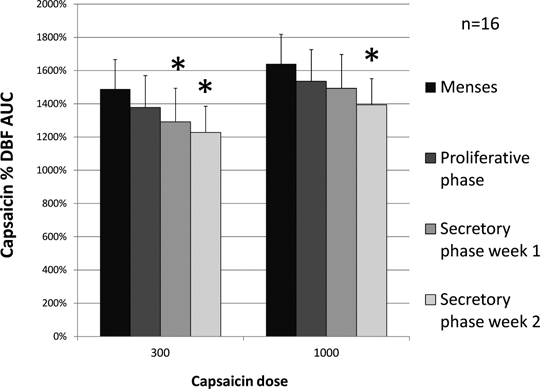.gif)
Influence of hormonal changes during the menstrual cycle on capsaicin-induced CGRP-mediated vasodilatation of the human skin Introduction: Migraine is in female patients associated with the menstrual cycle and changes of female sex hormone levels. More specifically, peaks of migraine frequency occur when estrogen levels drop; i.e. during days -3 to day +2 of the start of the menses, at the end of pregnancy (postpartum) and during the transition to menopause. Sex steroids can exert their nociceptive effect at the level of expression of neurotransmitters and their cognate receptors, and even at the level of downstream signaling (Gupta et al. 2011). Interesting nociceptive neuropeptides include calcitonin gene-related peptide (CGRP) and ion channels such as transient receptor potential vanilloid 1 (TRPV1), a nonselective cation channel that binds capsaicin. CGRP is a potent vasodilatator as well as a neuropeptide involved in pain transmission in the central and peripheral nervous system. Blocking CGRP in the trigemino-vascular system results in effective migraine treatment. This study aimed to investigate the influence of the female menstrual cycle on changes in skin perfusion resulting from the endogenous release of CGRP induced by the local application of capcaisin. Methods: Healthy, non-smoking female volunteers (n=16) not using hormonal contraceptives, were investigated weekly during 2 menstrual cycles. Subjects were included at random periods of their menstrual cycle. Every week, in 3 O-rings at the volar surface of both forearm, two doses of capsaicin (300 and 1000µg) and vehicle were applied topically on the skin. Dermal blood flow (DBF) was assessed before and at 10, 20, 30 and 40 minutes after capsaicin/vehicle application using laser Doppler imaging. This technique was reproducibly validated in healthy male volunteers (Van der Schueren et al. 2007) and CGRP was confirmed as the primary mediator involved (Van der Schueren et al. 2008). Results: Period differences in capsaicin-induced DBF, expressed as area-under-the-curve (AUC) percentage increase over 40 minutes, were observed both at capsaicin dose of 300µg and 1000µg (repeated-measures ANOVA, respectively p<0.001 and p<0.001). At the 300µg capsaicin dose, DBF response was higher during the menses compared to both weeks of the secretory phase of the menstrual cycle (t-test for dependent samples, respectively p=0.034 and p= 0.019). At the 1000µg capsaicin dose, DBF was higher during the menses compared to the last week of the secretory phase of the menstrual cycle (t-test for dependent samples, p=0.014). Results were summarized in the chart below (mean+SEM). Conclusion: In healthy women, a hormonal influence on capsaicin-induced CGRP-mediated vasodilation of the skin is observed. In particular, an increased dermal blood flow response after capsaicin application is documented during the menstruation period. This could be the result of increased neuronal sensitivity to capsaicin, increased release of CGRP or increased sensitivity to CGRP during the menstruation period. These results support the hypothesis that female hormones are related with the susceptibility to migraine. Gupta S et al, (2011). Headache 51, 905-922 Van der Schueren B et al, (2007). Br J Clin Pharmacol 64, 580-590 Van der Schueren B et al, (2008). J Pharmacol Exp Ther 325, 248-255
|


